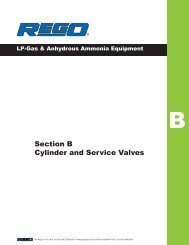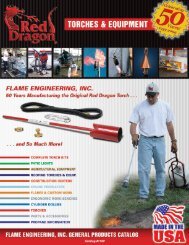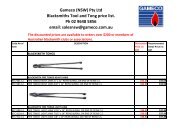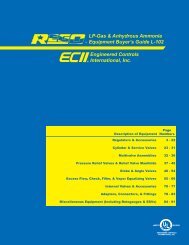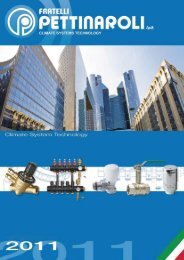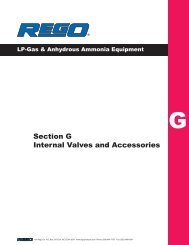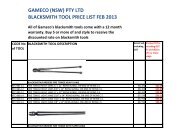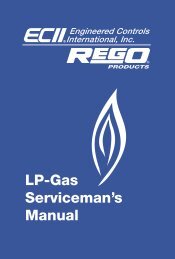Repair Kits Available By Part Number Section 2 Page - GAMECO
Repair Kits Available By Part Number Section 2 Page - GAMECO
Repair Kits Available By Part Number Section 2 Page - GAMECO
You also want an ePaper? Increase the reach of your titles
YUMPU automatically turns print PDFs into web optimized ePapers that Google loves.
WARNING: Installation, disassembly, repair and maintenance<br />
must be performed only by qualified personnel.<br />
All gas MUST be evacuated from the system before starting<br />
repairs.<br />
Installation, usage and maintenance of this product must be<br />
in compliance with all Engineered Controls International,<br />
Inc. instructions as well as requirements and provisions of<br />
NFPA #54, NFPA #58, DOT, ANSI, all applicable federal,<br />
state, provincial and local standards, codes, regulations<br />
and laws.<br />
Inspection and maintenance on a periodic basis is essential.<br />
Be sure all instructions are read and understood before<br />
installation, operation and maintenance. These instructions<br />
must be passed along to the end user of the product.<br />
CAUTION: Contact or inhalation of liquid propane, ammonia<br />
and their vapors can cause serious injury or death! NH 3<br />
and<br />
LP-Gas must be released outdoors in air currents that will<br />
insure dispersion to prevent exposure to people and livestock.<br />
LP-Gas must be kept far enough from any open flame<br />
or other source of ignition to prevent fire or explosion! LP-<br />
Gas is heavier than air and may not disperse or evaporate<br />
rapidly if released in still air.<br />
<strong>Repair</strong> Procedure<br />
CAUTION: READ THROUGH ALL OF THESE INSTRUCTIONS,<br />
INCLUDING THE NOTICE AND WARNINGS ON THE LAST<br />
PAGE OF THIS SHEET, BEFORE BEGINNING ANY DISASSEM-<br />
BLY OR REPAIR.<br />
NOTE:<strong>Repair</strong>s must be performed in a clean area. Hands,<br />
clothing, tools and work area must be completely free of oil,<br />
grease and foreign matter to prevent contamination of component<br />
parts and valves.<br />
NOTE:Before beginning relief valve removal or inspection, be<br />
sure protective eyewear and gloves are worn. Never look directly<br />
into the relief valves at any time because they may discharge and<br />
cause bodily injury.<br />
Removing Relief Valves from Manifold Assembly<br />
1. EVACUATE ALL GAS FROM THE SYSTEM BEFORE ANY<br />
DISASSEMBLY OR REPAIR.<br />
2. Turn the positioning handwheel so that arrow on the manifold<br />
body located directly below the handwheel is positioned<br />
midway between any two adjacent numbers on the handwheel.<br />
3. Turn the knob of each bleeder valve in a clockwise<br />
direction. This should allow any remaining vapor to bleed<br />
from the hole in bleeder valve body. After the discharge has<br />
stopped, the relief valves are ready to be removed.<br />
4. Remove the weep hole deflectors from the relief valves with<br />
an appropriate wrench. This will provide clearance and a grip<br />
for removing relief valves. See Figure 1.<br />
5. Remove safety relief valves from top of manifold assembly by<br />
turning valves counter-clockwise. Relief valves may be removed<br />
using an open end wrench, monkey wrench, pipe<br />
wrench, or chain wrench applied to the hex section of the<br />
relief valve. Save valves for reassembly.<br />
NOTE: In some cases, it may be necessary to remove the<br />
positioning handwheel to facilitate removal of relief valves one<br />
and four. If this is done, carefully note position of the handwheel<br />
and replace it in exactly the same position. Position can be<br />
verified by matching the number of the closed port with the<br />
number on the handwheel and the arrow stamped on the<br />
manifold body pad directly below the handwheel.<br />
PAGE 1<br />
8560-50 Assembly For<br />
A8560 and A8570 Series<br />
Multiport ® Pressure Relief<br />
Valve Manifold Assemblies<br />
Figure 1: Relief Valve Removal<br />
Use chain wrench, open end<br />
wrench, monkey wrench, or pipe<br />
wrench applied directly on hex<br />
section only.<br />
Weep Hole Deflector<br />
Remove to provide clearance<br />
for wrench.<br />
Removing Manifold Assembly from Container<br />
The manifold assembly may be removed from the container to<br />
continue repairs. The manifold assembly does not have to be<br />
removed for repairs.<br />
1. Remove the steel nuts from the steel bolt studs above the<br />
mating flange of the manifold assembly. Nuts are removed by<br />
turning counter-clockwise. See Figure 2. Save nuts and studs<br />
for reassembly.<br />
2. Remove relief valve manifold assembly from the container.<br />
3. Remove gasket located between manifold assembly and<br />
container. Discard gasket.<br />
Figure 2: Relief Valve Installations<br />
Manifold Installed on Manhole Cover Plate<br />
Gasket<br />
Manifold<br />
Asembly<br />
Manifold Installed on Welding Neck Flange<br />
Gasket<br />
Container<br />
Manifold<br />
Asembly<br />
Container<br />
Steel Bolt Studs<br />
Steel Nuts<br />
Manhole Cover Plate<br />
Steel Bolt Studs<br />
Steel Nuts<br />
Welding Neck Flange



